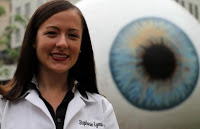
MainosMemos contains the latest research and information about eye and vision care of children, developmental disabilities, Traumatic/Acquired Brain Injury and other topics of interest to me (and hopefully you!).
Saturday, June 16, 2012
Research on Convergence Insufficiency
It is important that we know and understand this research for our patients' benefit. This research clearly shows that in-office optometric vision therapy is the most efficacious treatment for convergence insufficiency. Major insurance companies are denying in-office vision therapy unless you conduct out of office/home therapy first. This rational for the patient having 12 out of office vision/home
based therapy sessions before in office therapy is inappropriate, unsubstantiated
by research and potentially harmful to our patient's well being and quality of
life.They are recommending the least effective, most time consuming, and
costly methodology of treatment. I respectfully request that these insurance companies reconsider this ill
advised policy immediately.
If you are a patient reading this, go to your employer and ask them to support vision therapy by telling your insurance company to do no harm, to waste no money, and to support treatments shown to be effective. DM
Borsting E, Mitchell GL, Kulp MT, Scheiman M, Amster DM, Cotter S, Coulter RA, Fecho G, Gallaway MF, Granet D, Hertle R, Rodena J, Yamada T; CITT Study Group.
Optom Vis Sci. 2012 Jan;89(1):12-8.
Scheiman M, Cotter S, Kulp MT, Mitchell GL, Cooper J, Gallaway M, Hopkins KB, Bartuccio M, Chung I; Convergence Insufficiency Treatment Trial Study Group.
Optom Vis Sci. 2011 Nov;88(11):1343-52.
Scheiman M.
J AAPOS. 2011 Apr;15(2):123-4. No abstract available.
Scheiman M, Gwiazda J, Li T.
Cochrane Database Syst Rev. 2011 Mar 16;(3):CD006768. Review.
Vision therapy/orthoptics for symptomatic convergence insufficiency in children: treatment kinetics.
Scheiman M, Kulp MT, Cotter S, Mitchell GL, Gallaway M, Boas M, Coulter R, Hopkins K, Tamkins S; Convergence Insufficiency Treatment Trial Study Group.
Optom Vis Sci. 2010 Aug;87(8):593-603.
Cotter S, Kulp M, Scheiman M, Hertle R, Mitchell GL, Rouse M; Convergence Insufficiency Treatment Trial Executive Committee.
Arch Ophthalmol. 2009 Sep;127(9):1229-30; author reply 1230-1. No abstract available.
Academic behaviors in children with convergence insufficiency with and without parent-reported ADHD.
Rouse M, Borsting E, Mitchell GL, Kulp MT, Scheiman M, Amster D, Coulter R, Fecho G, Gallaway M; CITT Study Group.
Optom Vis Sci. 2009 Oct;86(10):1169-77.
Convergence Insufficiency Treatment Trial Study Group.
Optom Vis Sci. 2009 Sep;86(9):1096-103.
Scheiman M, Rouse M, Kulp MT, Cotter S, Hertle R, Mitchell GL.
Optom Vis Sci. 2009 May;86(5):420-8.
Rouse M, Borsting E, Mitchell GL, Cotter SA, Kulp M, Scheiman M, Barnhardt C, Bade A, Yamada T; Convergence Insufficiency Treatment Trial (CITT) Investigator Group.
Optom Vis Sci. 2009 Apr;86(4):357-63. Erratum in: Optom Vis Sci. 2009 Jun;86(6):786. Yamada, Tomohike [corrected to Yamada, Tomohiko].
Kulp M, Mitchell GL, Borsting E, Scheiman M, Cotter S, Rouse M, Tamkins S, Mohney BG, Toole A, Reuter K; Convergence Insufficiency Treatment Trial Study Group.
Invest Ophthalmol Vis Sci. 2009 Jun;50(6):2560-6. Epub 2009 Jan 17.
Kulp MT, Borsting E, Mitchell GL, Scheiman M, Cotter S, Cooper J, Rouse M, London R, Wensveen J; Convergence Insufficiency Treatment Trial (CITT) Investigator Group.
Optom Vis Sci. 2008 Apr;85(4):255-61.
Convergence Insufficiency Treatment Trial (CITT) Study Group.
Ophthalmic Epidemiol. 2008 Jan-Feb;15(1):24-36.Free PMC Article
Scheiman M, Mitchell GL, Cotter S, Rouse M, Borsting E, Kulp M, Cooper J, London R, Wensveen J; Convergence Insufficiency Treatment Trial (CITT) Study Group.
Optom Vis Sci. 2006 Nov;83(11):857-8; author reply 858-9. No abstract available.
Scheiman M, Cotter S, Rouse M, Mitchell GL, Kulp M, Cooper J, Borsting E; Convergence Insufficiency Treatment Trial Study Group.
Br J Ophthalmol. 2005 Oct;89(10):1318-23.
Scheiman M, Mitchell GL, Cotter S, Kulp MT, Cooper J, Rouse M, Borsting E, London R, Wensveen J.
Optom Vis Sci. 2005 Jul;82(7):583-95.
Scheiman M, Mitchell GL, Cotter S, Cooper J, Kulp M, Rouse M, Borsting E, London R, Wensveen J; Convergence Insufficiency Treatment Trial Study Group.
Arch Ophthalmol. 2005 Jan;123(1):14-24.
Rouse MW, Borsting EJ, Mitchell GL, Scheiman M, Cotter SA, Cooper J, Kulp MT, London R, Wensveen J; Convergence Insufficiency Treatment Trial Group.
Ophthalmic Physiol Opt. 2004 Sep;24(5):384-90.
Borsting EJ, Rouse MW, Mitchell GL, Scheiman M, Cotter SA, Cooper J, Kulp MT, London R; Convergence Insufficiency Treatment Trial Group.
Optom Vis Sci. 2003 Dec;80(12):832-8.
Scheiman M, Gallaway M, Frantz KA, Peters RJ, Hatch S, Cuff M, Mitchell GL.
Optom Vis Sci. 2003 Mar;80(3):214-25.
21.
Gallaway M, Scheiman M, Malhotra K.
Optom Vis Sci. 2002 Apr;79(4):265-7.
Scheiman M, Cooper J, Mitchell GL, de LP, Cotter S, Borsting E, London R, Rouse M.
Optom Vis Sci. 2002 Mar;79(3):151-7.
Rouse MW, Borsting E, Hyman L, Hussein M, Cotter SA, Flynn M, Scheiman M, Gallaway M, De Land PN.
Optom Vis Sci. 1999 Sep;76(9):643-9.
Scheiman M, Blaskey P, Ciner EB, Gallaway M, Parisi M, Pollack K, Selznick R.
J Am Optom Assoc. 1990 Aug;61(8):600-5.
Gallaway M, Vaxmonsky T, Scheiman M.
J Am Optom Assoc. 1989 Jun;60(6):428-34.
Scheiman M, Gallaway M, Ciner E.
Am J Optom Physiol Opt. 1986 Jun;63(6):425-31. Review.
Scheiman MM, Peli E, Libassi D.
J Am Optom Assoc. 1983 Nov;54(11):1001-3. No abstract available.
Long-term follow-up of bilateral botulinum toxin injections versus bilateral recessions of the medial rectus muscles for treatment of infantile esotropia.
Long-term follow-up of bilateral botulinum toxin injections versus bilateral recessions of the medial rectus muscles for treatment of infantile esotropia.
...There was no difference in binocular alignment with botulinum toxin versus surgical treatment. Botulinum toxin injection may be considered a primary treatment for infantile esotropia.....
Comments: The abstract did not say exactly what the success rate was. If the success rate was typical of strabismus surgery, then the success rate of botulinum toxin injection was terrible. DM
Friday, June 15, 2012
Certain Features Of Autism May Be Improved By Antioxidant
Certain Features Of Autism May Be Improved By Antioxidant
.....The antioxidant, called N-Acetylcysteine, or NAC, lowered irritability in children with autism as well as reducing the children's repetitive behaviors. The researchers emphasized that the findings must be confirmed in a larger trial before NAC can be recommended for children with autism......
Thursday, June 14, 2012
Decline In Vaccinations Of U.S. Children After Publication Of Now-Refuted Autism Risk
 Decline In Vaccinations Of U.S. Children After Publication Of Now-Refuted Autism Risk
...UC health economics research has found that publication of perceived risk linking the MMR (measles, mumps, rubella) vaccine to autism in the late 1990s seemingly led to declines in the vaccination rate of children. This despite the fact that later studies refuted the existence of an MMR-autism link. ...
Comments: Have your children vaccinated now! If you do not, please keep them at home never to interact with other children or adults.Measles are on the rise once again...as well as other contagious diseases. Have your children vaccinated. DM
Decline In Vaccinations Of U.S. Children After Publication Of Now-Refuted Autism Risk
...UC health economics research has found that publication of perceived risk linking the MMR (measles, mumps, rubella) vaccine to autism in the late 1990s seemingly led to declines in the vaccination rate of children. This despite the fact that later studies refuted the existence of an MMR-autism link. ...
Comments: Have your children vaccinated now! If you do not, please keep them at home never to interact with other children or adults.Measles are on the rise once again...as well as other contagious diseases. Have your children vaccinated. DM
Contact Lens Care: Soft Sell, Done Well
This is a video brought to my attention by my friend and colleague, Dr. Mike Cohen, in his NewsLetter OD2OD. He noted that this nicely depicts our patients' daily routine...and how to take care of contacts by this solution manufacturer. Nicely done.
Tuesday, June 12, 2012
Vision Problems Coming to an Amusement Park Near You
.....The
3D craze on the big screen is spreading to new ground - or should we
say, grounds. Universal Studios Hollywood announces a new, 3D theme
park attraction “Transformers the Ride 3-D.”
While this will be great fun for most theme park goers, it will be
frustrating to people with vision problems for a number of different
reasons...... read more about it here.
Accommodative lag and refractive error in infants and toddlers
Accommodative lag and refractive error in infants and toddlers
....Analysis of data from 189 of 203 subjects (children ages 5 to 24 months) revealed that larger lags and lower gain of the accommodative response were more common in younger children, ..... Larger accommodation lags were associated with greater spherical equivalent refractive error, ....
....Analysis of data from 189 of 203 subjects (children ages 5 to 24 months) revealed that larger lags and lower gain of the accommodative response were more common in younger children, ..... Larger accommodation lags were associated with greater spherical equivalent refractive error, ....
Monday, June 11, 2012
Optometry Does Well Even in Recession
...Growth in the Optometrists industry
persisted through the economic recession, mainly due to resilient
demand from the aging population and eye diseases associated with
diabetes and computer use. During the five years to 2012, revenue is
expected to increase at an annualized rate of 2.9% to $14.0 billion.
While low disposable income and high unemployment deterred some
consumers from seeking eye care, operators maintained growth by reducing
prices and catering to favorably shifting demographics.....
Clinical characteristics, course, and visual prognosis of partial cataracts that seem to be visually insignificant in children
Clinical characteristics, course, and visual prognosis of partial cataracts that seem to be visually insignificant in children
...Most patients with partial cataracts that seemed to be visually insignificant and were treated without surgery did not progress and showed favorable visual outcomes. In children who had progressive vision loss, surgery was necessary: these patients also had favorable visual outcomes....
...Most patients with partial cataracts that seemed to be visually insignificant and were treated without surgery did not progress and showed favorable visual outcomes. In children who had progressive vision loss, surgery was necessary: these patients also had favorable visual outcomes....
Dr. Dominick Maino See Patients at Lyons Family Eye Care
Dr. Maino Now at Lyons Family Eye Care
 Dr. Stephanie Lyons
is the chief
optometrist and owner of Lyons Family Eye Care. She is a graduate of
the
University of Illinois and a former student of Dr. Maino's at the
Illinois College of Optometry where she graduated Cum Laude with honor.
She is a leader within her profession who also writes a monthly article
for the American
Optometric Association’s nationally distributed newsletter for the
Contact Lens and Cornea Section. Dr. Lyons also enjoys reading,
cooking, traveling, cheering for the Illini, and spending time with her
family.
Dr. Stephanie Lyons
is the chief
optometrist and owner of Lyons Family Eye Care. She is a graduate of
the
University of Illinois and a former student of Dr. Maino's at the
Illinois College of Optometry where she graduated Cum Laude with honor.
She is a leader within her profession who also writes a monthly article
for the American
Optometric Association’s nationally distributed newsletter for the
Contact Lens and Cornea Section. Dr. Lyons also enjoys reading,
cooking, traveling, cheering for the Illini, and spending time with her
family.
Mr. John Lyons is the general manager,
owner of Lyons Family Eye Care and the spouse of Dr. Lyons. With a diverse background in business,
his dream has always been to have a small business of his own. That
dream combined with his wife Stephanie’s desire to have an optometry
practice led to the creation of Lyons Family Eye Care. He is
passionate about customer service and creating a friendly atmosphere for
patients and staff. In his free
time, John enjoys sports, traveling, competing in triathlons, and taking
care of his family including his two dogs Chance and Lucky. John is
also active in the Lakeview Chamber of Commerce and on the board of West
LakeView Neighbors.
Dr.
Dominick Maino is a Professor of Pediatrics/Binocular Vision at the Illinois
Eye Institute/Illinois College of Optometry. He graduated from the Illinois College of
Optometry, received his MEd at the University of Illinois Chicago and
Bachelor’s degree from Beloit College. Dr. Maino is the past Director of the
Institute for Advanced Competency Post-Graduate Continuing Education Program,
an Adjunct Professor of Pediatrics/Binocular Vision at the Centro Boston de
Optometria in Madrid Spain, and the Director of the Developmental Disabilities
Service at Neumann Family Services. He is a Fellow of both the American Academy
of Optometry and the College of Optometrists in Vision Development, and holds
membership in the American & Illinois Optometric Associations,
Neuro-Optometric Rehabilitation Association, and the Artists of Casa Italia.
His recent activities includes presenting at the International Brain Injury
Association meeting in Edinburgh, Scotland; at the California Optometric
Association’s OptoWest Conference and as a member of an expert panel at the
American Conference of Pediatric Cerebral Visual Impairment which is sponsored
by the Children’s Hospital, Omaha, NE.
Dr. Maino
currently serves as the editor of Optometry
and Vision Development, and has authored approximately 200 books, chapters,
and articles. He has given more than 100 presentations worldwide, is a
co-author of the technology column for the AOANews and is currently the
associate, consulting, and/or contributing editor/manuscript reviewer for numerous
publications. Lippincott, Williams & Wilkins has recently agreed to publish
Dr. Maino’s next book, Visual Diagnosis
and Care of the Patient with Special Needs which will be available May 2012.
Dr.
Maino has received recognition for his work from the Order
Sons of Italy (Leonardo Da Vinci Award for Excellence in Medicine),
National
Academies of Practice (Distinguished Practitioner), Neuro-Optometric
Rehabilitation Association, College of Optometrists in Vision
Development,
Optometric Editors Association, and the Easter Seal Society of
Metropolitan
Chicago. He is an internationally recognized expert on oculo-visual
problems of
children and adults with a special interest in the patient with special
needs.
His research interests include special populations, pediatrics, and
binocular
vision dysfunction. He is currently the spokesperson for the American
Optometric
Association on 3 D Vision Syndrome and has been interviewed numerous
times (television,
print media, radio, Internet) on this topic. Dr. Maino’s avocations
include blogging, music, photography and as a budding connoisseur of the
finer points of appreciating a good Single Malt Scotch(especially after
a trip to Scotland), is now attempting to age his own micro-barrel,
very small batch whiskey.
Sunday, June 10, 2012
National Center for Complementary and Alternative Medicine-funded randomised controlled trials of acupuncture: a systematic review
National Center for Complementary and Alternative Medicine-funded randomised controlled trials of acupuncture: a systematic review
...The work of the National Center for Complementary and Alternative Medicine (NCCAM) has repeatedly been criticised. Much of this criticism relates to the past funding of studies of acupuncture. The aim of this article is to provide an independent, critical evaluation of the data produced by NCCAM-funded RCTs of acupuncture. Relevant studies were identified using PubMed. Studies were included if they were NCCAM-funded RCTs of acupuncture. Excluded were secondary reports of primary studies, RCTs not testing the effectiveness of acupuncture and National Institutes of Health-funded studies not mentioning NCCAM support. One author extracted the data according to predefined criteria and assessed the risk of bias. The other authors verified these tasks. Thirteen RCTs were included, with sample sizes ranging from seven to 570. Most studies reported pain as the primary outcome. Six RCTs suggested acupuncture was effective. Seven RCTs had a low risk of bias. Numerous methodological shortcomings were identified. Many NCCAM-funded RCTs of acupuncture have important limitations. These findings might improve future studies of acupuncture and could be considered in the ongoing debate regarding NCCAM-funding. ...
Comments: Read full article by clicking the link above. DM
Underweight Infants Have Better Outcomes At Hospitals Recognized For Nursing Excellence
Underweight Infants Have Better Outcomes At Hospitals Recognized For Nursing Excellence
....A study in the April 25 edition of JAMA shows that very low-birth-weight infants that were born in hospitals recognized for nursing excellence (RNE), compared with those that had not, had a substantially lower rate of hospital infection, severe intraventricular hemorrhage and death at 7-days, but no lower rates of death at 28-days or hospital stay mortality. The study included over 72,000 very low-birth-weight infants......
Comments: Chicago's newest (and at the same time oldest) children's hospital, Ann & Robert H. Lurie Children's Hospital of Chicago (aka Children's Memorial Hospital and Medical Center), has everything it takes for better outcomes for all children who require a hospital stay. I spent several hours at the new facility yesterday....and all children ...when they need medical care in a hospital...should go to this magnificent health care facility. State of the art, hi-tech....very hi-touch health care at its finest. DM
....A study in the April 25 edition of JAMA shows that very low-birth-weight infants that were born in hospitals recognized for nursing excellence (RNE), compared with those that had not, had a substantially lower rate of hospital infection, severe intraventricular hemorrhage and death at 7-days, but no lower rates of death at 28-days or hospital stay mortality. The study included over 72,000 very low-birth-weight infants......
Comments: Chicago's newest (and at the same time oldest) children's hospital, Ann & Robert H. Lurie Children's Hospital of Chicago (aka Children's Memorial Hospital and Medical Center), has everything it takes for better outcomes for all children who require a hospital stay. I spent several hours at the new facility yesterday....and all children ...when they need medical care in a hospital...should go to this magnificent health care facility. State of the art, hi-tech....very hi-touch health care at its finest. DM
Subscribe to:
Posts (Atom)


